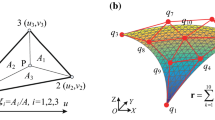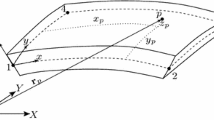Abstract
The past few years have witnessed rapid advances in the integration of Computer-Aided Design (CAD) and Finite Element Analysis (FEA), such as the Isogeometric Analysis (IGA) method and the Integration of Computer Aided Design and Analysis (I-CAD-A) technique. Recent studies indicated that the geometry description used in the Absolute Nodal Coordinate Formulation (ANCF) is consistent with the geometry description in CAD systems, making it an attractive approach for I-CAD-A. ANCF as an accurate, non-incremental finite element method to deal with the dynamics of those systems subject to large motions and large deformations has developed towards practical application in the field of flexible multibody systems. The objective of this study is to enrich the family of ANCF elements with three new triangular shell elements: the thin triangular element, the low order thick triangular element and the high order thick triangular element, which are represented by Bézier triangles. The linear mapping relationship between the geometrical representation of the Bézier triangle and that of the proposed thin triangular element is established. The invertible property of the linear mapping relationship clearly indicates that the proposed thin triangular element can be also used to perform the I-CAD-A. The conditions of the approximate \(G^{1}\) continuity between the proposed adjacent elements are also deduced in order to construct a smooth surface. Finally, several static and dynamic numerical examples are employed to validate the correctness and effectiveness of the proposed triangular shell elements.




























Similar content being viewed by others
References
Farin, G.: Curves and Surfaces for CAGD: A Practical Guide. Morgan Kaufmann, San Mateo (2001)
Ernens, D.: Finite element methods with exact geometry representation. Master’s Thesis, Delft University of Technology (2011)
Piegl, L., Tiller, W.: The NURBS Book, 2nd edn. Springer, Berlin (1997)
Rogers, D.F.: An Introduction to NURBS: With Historical Perspective. Morgan Kaufmann, San Mateo (2001)
Shabana, A.A.: Computational Dynamics, 2nd edn. Wiley, New York (2001)
Shabana, A.A.: Uniqueness of the geometric representation in large rotation finite element formulations. J. Comput. Nonlinear Dyn. 5, 044501 (2010)
Cottrell, J.A., Hughes, T.J.R., Bazilevs, Y.: Isogeometric Analysis—Toward Integration of CAD and FEA. Wiley, New York (2009)
Hughes, T.J.R., Cottrell, J.A., Bazilevs, Y.: Isogeometric analysis: CAD, finite elements, NURBS, exact geometry and mesh refinement. Comput. Methods Appl. Mech. Eng. 194(39), 4135–4195 (2005)
Sanborn, G.G., Shabana, A.A.: A rational finite element method based on the absolute nodal coordinate formulation. Nonlinear Dyn. 58(3), 565–572 (2009)
Sanborn, G.G., Shabana, A.A.: On the integration of computer aided design and analysis using the finite element absolute nodal coordinate formulation. Multibody Syst. Dyn. 22(2), 181–197 (2009)
Shabana, A.A.: An absolute nodal coordinates formulation for the large rotation and deformation analysis of flexible bodies. Technical Report. No. MBS96-1-UIC, University of Illinois at Chicago, (1996)
Schiehlen, W.: Research trends in multibody system dynamics. Multibody Syst. Dyn. 18, 3–13 (2007)
Shabana, A.A.: Flexible multibody dynamics review of past and recent developments. Multibody Syst. Dyn. 1, 189–222 (1997)
Dmitrochenko, O.N., Pogorelov, D.Y.: Generalization of plate finite elements for absolute nodal coordinate formulation. Multibody Syst. Dyn. 10(1), 17–43 (2003)
Dufva, K., Shabana, A.A.: Analysis of thin plate structures using the absolute nodal coordinate formulation. Proc. Inst. Mech. Eng., Proc., Part K, J. Multi-Body Dyn. 219, 345–355 (2005)
Tian, Q., Chen, L., Zhang, Y.Q., Yang, J.: An efficient hybrid method for multibody dynamics simulation based on absolute nodal coordinate formulation. J. Comput. Nonlinear Dyn. 4, 021009 (2009)
Liu, C., Tian, Q., Hu, H.Y.: Dynamics of a large scale rigid–flexible multibody system composed of composite laminated plate. Multibody Syst. Dyn. 26(3), 283–305 (2011)
Yan, D., Liu, C., Tian, Q., Zhang, K., Liu, X.N., Hu, G.K.: A new curved gradient deficient shell element of absolute nodal coordinate formulation for modeling thin shell structures. Nonlinear Dyn. 74, 153–164 (2013)
Lan, P., Shabana, A.A.: Integration of B-spline geometry and ANCF finite element analysis. Nonlinear Dyn. 61, 193–206 (2010)
Mikkola, A.M., Shabana, A.A., Sanchez-Rebollo, C., Jimenez-Octavio, J.R.: Comparison between ANCF and B-spline surfaces. Multibody Syst. Dyn. 30(2), 119–138 (2013)
Farin, G.: Triangular Bernstein–Bézier patches. Comput. Aided Geom. Des. 3(2), 83–127 (1986)
Yamashita, H., Sugiyama, H.: Numerical convergence of finite element solutions of nonrational B-spline element and absolute nodal coordinate formulation. Nonlinear Dyn. 67(1), 177–189 (2012)
Shabana, A.A., Hamed, A.M., Mohamed, A.N.A., Jayakumar, P., Letherwood, M.D.: Use of B-spline in the finite element analysis: comparison with ANCF geometry. J. Comput. Nonlinear Dyn. 7(1), 011008 (2012)
Nada, A.A.: Use of B-spline surface to model large-deformation continuum plates: procedure and applications. Nonlinear Dyn. 72, 243–263 (2013)
Bauchau, O.A., Han, S.l., Mikkola, A.M., Matikainen, M.K.: Comparison of the absolute nodal coordinate and geometrically exact formulations for beams. Multibody Syst. Dyn. 32(1), 67–85 (2013)
Mikkola, A.M., Shabana, A.A.: A non-incremental finite element procedure for the analysis of large deformation of plates and shells in mechanical system applications. Multibody Syst. Dyn. 9(3), 283–309 (2003)
Matikainen, M.K., Valkeapää, A.I., Mikkola, A.M., Schwab, A.L.: A study of moderately thick quadrilateral plate elements based on the absolute nodal coordinate formulation. Multibody Syst. Dyn. (2013). doi:10.1007/s11044-013-9383-6
Liu, C., Tian, Q., Yan, D., Hu, H.Y.: Dynamic analysis of membrane systems undergoing overall motion large deformations and wrinkles via thin shell elements of ANCF. Comput. Methods Appl. Mech. Eng. 258, 81–95 (2013)
Dmitrochenko, O., Mikkola, A.M.: Two simple triangular plate elements based on the absolute nodal coordinate formulation. J. Comput. Nonlinear Dyn. 3(4), 041012-1–041012-8 (2008)
Specht, B.: Modified shape functions for the three–node plate bending element passing the patch test. Int. J. Numer. Methods Eng. 26(3), 705–715 (1988)
Morley, L.S.D.: The constant-moment plate-bending element. J. Strain Anal. 6(1), 20–24 (1971)
Mohamed, A.A.: Three-dimensional fully parameterized triangular plate element based on the absolute nodal coordinate formulation. J. Comput. Nonlinear Dyn. 8(4), 041016-1–041016-7 (2013)
Ubach, P.A., Oñate, E.: New rotation-free finite element shell triangle accurately using geometrical data. Comput. Methods Appl. Mech. Eng. 199(5), 383–391 (2010)
Liu, Y.: Triangular Bézier surfaces with approximate continuity. University of Waterloo, Ph.D. Thesis (2008)
Shi, F.: Computer-Aided Geometric Design and Non-uniform Rational B-spline. Higher Education Press, Beijing (2001) (in Chinese)
Mann, S.: Continuity adjustments to triangular Bézier patches that retain polynomial precision. Research Report CS-2000-01 (2000)
Liu, D., Hoschek, J.: GC1 continuity conditions between adjacent rectangular and triangular Bézier surface patches. Comput. Aided Des. 21(4), 194–200 (1989)
Shabana, A.A., Mikkola, A.M.: Use of the finite element absolute nodal coordinate formulation in modeling slope discontinuity. J. Mech. Des. 125, 342–350 (2003)
Shabana, A.A., Maqueda, L.G.: Slope discontinuities in the finite element absolute nodal coordinate formulation: gradient deficient elements. Multibody Syst. Dyn. 20(3), 239–249 (2008)
Bathe, K.J.: Finite Element Procedures. Prentice-Hall, New Jersey (1996)
Belytschko, T., Liu, W.K., Moran, B., Elkhodary, K.I.: Nonlinear Finite Element for Continua and Structures. Wiley, New York (2013)
Gerstmayr, J., Shabana, A.A.: Efficient integration of the elastic forces and thin three-dimensional beam elements in the absolute nodal coordinate formulation. In: Proceedings of the Multibody Dynamics Eccomas Thematic Conference, Madrid, Spain, 21–24 June (2005)
Liu, C., Tian, Q., Hu, H.Y.: New spatial curved beam and cylindrical shell elements of gradient-deficient absolute nodal coordinate formulation. Nonlinear Dyn. 70(3), 1903–1918 (2012)
Hussein, B., Negrut, D., Shabana, A.A.: Implicit and explicit integration in the solution of the absolute nodal coordinate differential/algebraic equations. Nonlinear Dyn. 54, 283–296 (2008)
Shabana, A.A., Hussein, B.: A two–loop sparse matrix numerical integration procedure for the solution of differential/algebraic equations: application to multibody systems. J. Sound Vib. 327, 557–563 (2009)
Hussein, B., Shabana, A.A.: Sparse matrix implicit numerical integration of the stiff differential/algebraic equation: implementation. Nonlinear Dyn. 65, 369–382 (2011)
Chung, J., Hulbert, G.: A time integration algorithm for structural dynamics with improved numerical dissipation: the generalized-alpha method. J. Appl. Mech. 60, 371–375 (1993)
Arnold, M., Brüls, O.: Convergence of the generalized-alpha scheme for constrained mechanical systems. Multibody Syst. Dyn. 18, 185–202 (2007)
Tian, Q., Zhang, Y., Chen, L., Yang, J.J.: Simulation of planar flexible multibody systems with clearance and lubricated revolute joints. Nonlinear Dyn. 60, 489–511 (2010)
Tian, Q., Liu, C., Machado, M., Flores, P.: A new model for dry and lubricated cylindrical joints with clearance in spatial flexible multibody systems. Nonlinear Dyn. 64, 25–67 (2011)
Liu, C., Tian, Q., Hu, H.Y.: Dynamics and control of a spatial rigid–flexible multibody system with multiple cylindrical clearance joints. Mech. Mach. Theory 52, 106–129 (2012)
Hermanns, M.: Parallel programming in Fortran 95 using OpenMP (2002). http://www.openmp.org/presentations/miguel/F95_OpenMPv1_v2.pdf
Kulikov, G.M., Plotnikova, S.V.: Non-linear exact geometry 12-node solid-shell element with three translational degrees of freedom per node. Int. J. Numer. Methods Eng. 88(13), 1363–1389 (2011)
Arciniega, R.A., Reddy, J.N.: Tensor-based finite element formulation for geometrically nonlinear analysis of shell structures. Comput. Methods Appl. Mech. Eng. 196(4), 1048–1073 (2007)
Tian, Q., Sun, Y.L., Liu, C., Hu, H.Y., Flores, P.: Elastohydrodynamic lubricated cylindrical joints for rigid-flexible multibody dynamics. Comput. Struct. 114, 106–120 (2013)
Sze, K.Y., Liu, X.H., Lo, S.H.: Popular benchmark problems for geometric nonlinear analysis of shells. Finite Elem. Anal. Des. 40, 1551–1569 (2004)
Acknowledgements
This work was supported in part by National Natural Science Foundations of China under Grants 11290151, 11221202 and 11302025. The work was also supported in part by Excellent Young Scholar Research Fund from Beijing Institute of Technology, and supported in part by the Beijing Higher Education Young Elite Teacher Project under Grant YETP1201.
Author information
Authors and Affiliations
Corresponding author
Rights and permissions
About this article
Cite this article
Chang, H., Liu, C., Tian, Q. et al. Three new triangular shell elements of ANCF represented by Bézier triangles. Multibody Syst Dyn 35, 321–351 (2015). https://doi.org/10.1007/s11044-015-9462-y
Received:
Accepted:
Published:
Issue Date:
DOI: https://doi.org/10.1007/s11044-015-9462-y




